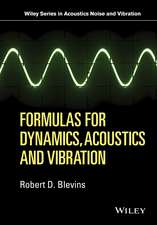Submarine Landslides and Tsunamis: NATO Science Series: IV:, cartea 21
Editat de Ahmet C. Yalçiner, Efim N. Pelinovsky, Emile Okal, Costas E. Synolakisen Limba Engleză Paperback – 31 dec 2003
Din seria NATO Science Series: IV:
- 18%
 Preț: 1225.94 lei
Preț: 1225.94 lei - 15%
 Preț: 640.06 lei
Preț: 640.06 lei - 18%
 Preț: 953.65 lei
Preț: 953.65 lei - 18%
 Preț: 950.84 lei
Preț: 950.84 lei - 18%
 Preț: 950.96 lei
Preț: 950.96 lei - 18%
 Preț: 948.61 lei
Preț: 948.61 lei - 18%
 Preț: 945.92 lei
Preț: 945.92 lei - 15%
 Preț: 644.63 lei
Preț: 644.63 lei - 18%
 Preț: 945.92 lei
Preț: 945.92 lei -
 Preț: 402.56 lei
Preț: 402.56 lei - 18%
 Preț: 1229.91 lei
Preț: 1229.91 lei - 15%
 Preț: 646.43 lei
Preț: 646.43 lei - 15%
 Preț: 647.08 lei
Preț: 647.08 lei - 18%
 Preț: 1230.21 lei
Preț: 1230.21 lei - 15%
 Preț: 657.57 lei
Preț: 657.57 lei - 18%
 Preț: 1835.83 lei
Preț: 1835.83 lei - 18%
 Preț: 1825.12 lei
Preț: 1825.12 lei - 18%
 Preț: 958.73 lei
Preț: 958.73 lei - 18%
 Preț: 951.29 lei
Preț: 951.29 lei - 18%
 Preț: 944.51 lei
Preț: 944.51 lei - 18%
 Preț: 1015.55 lei
Preț: 1015.55 lei - 15%
 Preț: 647.08 lei
Preț: 647.08 lei - 18%
 Preț: 1827.80 lei
Preț: 1827.80 lei - 18%
 Preț: 1835.53 lei
Preț: 1835.53 lei -
 Preț: 395.63 lei
Preț: 395.63 lei - 18%
 Preț: 944.99 lei
Preț: 944.99 lei
Preț: 394.51 lei
Nou
Puncte Express: 592
Preț estimativ în valută:
75.50€ • 78.53$ • 62.33£
75.50€ • 78.53$ • 62.33£
Carte tipărită la comandă
Livrare economică 12-26 aprilie
Preluare comenzi: 021 569.72.76
Specificații
ISBN-13: 9781402013492
ISBN-10: 1402013493
Pagini: 360
Ilustrații: XXI, 328 p.
Dimensiuni: 160 x 240 x 19 mm
Greutate: 0.57 kg
Ediția:2003
Editura: SPRINGER NETHERLANDS
Colecția Springer
Seria NATO Science Series: IV:
Locul publicării:Dordrecht, Netherlands
ISBN-10: 1402013493
Pagini: 360
Ilustrații: XXI, 328 p.
Dimensiuni: 160 x 240 x 19 mm
Greutate: 0.57 kg
Ediția:2003
Editura: SPRINGER NETHERLANDS
Colecția Springer
Seria NATO Science Series: IV:
Locul publicării:Dordrecht, Netherlands
Public țintă
ResearchCuprins
1. General Aspects of Tsunami Researches.- 1-1. Tsunamis of Seismic Origin; Science, Disasters and Mitigation.- 1-2. Needs and Perspectives of Tsunami Research in Europe.- 2. Historical Tsunamis.- 2-1. Identification of Slide-generated Tsunamis in the Historical Catalogues.- 2-2. Updating and Revision of the European Tsunami Catalogue.- 2-3. Tsunami of Sarkyö-Mürefte 1912 Earthquake: Western Marmara, Turkey.- 2-4. Spatial and Temporal Periodicity in the Pacific Tsunami Occurrence.- 3. Submarine Landslides and Tsunami Generation.- 3-1. Submarine Landslide Generated Waves Modeled Using Depth-Integrated Equations.- 3-2. Near Field Amplitudes of Tsunami from Submarine Slumps and Slides.- 3-3. Numerical Modeling of Tsunami Generation by Submarine and Subaerial landslides.- 3-4. Tsunami Simulation Taking Into Account Seismically Induced Dynamic Seabed Displacement and Acoustic Effects of Water.- 3-5. Impulsive Tsunami Generation by Rapid Bottom Deflections at Initially Uniform Depth.- 3-6. Analytical Models of Tsunami Generation by Submarine Landslides.- 3-7. Tsunami Generation in Compressible Ocean of Variable Depth.- 3-8. Tsunami Wave Excitation by a Local Floor Disturbance.- 3-9. Effects of Tsunami at Sissano Lagoon, Papua New Guinea: Submarine-Landslide and Tectonics Origins.- 3-10. Natural Gas Hydrates as a Cause of Underwater Landslides: A Rewiev.- 3-11. Coastal Deformation Occurred During the August 17, 1999 ?zmit Earthquake.- 4. Tsunami Propagation and Coastal Impact.- 4-1. A Review of Some Tsunamis in Canada.- 4-2. Synthetic Tsunami Simulations for the French Coasts.- 4-3. Inundation Modeling of the 1964 Tsunami in Kodiak Island, Alaska.- 4-4. A Method for Mathematical Modelling of Tsunami Runup on a Shore.- 4-5. Evaluation of Tsunami Hazard for the SouthernKamchatka Coast Using Historical and Paleotsunami data.- 4-6. Tsunami Hazards Associated With Explosion- Collapse Processes of a Dome Complex on Minoan Thera.- 4-7. Possible Tsunami Deposits Discovered on the Bulgarian Black Sea Coast and Some Applications.- 4-8. Influence of the Atmospheric Wave Velocity in the Coastal Amplification of Meteotsunamis.- 4-9. Impact of Surface Waves on the Coastal Ecosystems.- 5. Mitigation.- 5-1. Engineering Standards for Marine Oil Terminals and Other Natural Hazard Threats.- 5-2. A Tsunami Mitigation Program within the California Earthquake Loss Reduction Plan.- 5-3. Short-Term Inundation Forecasting For Tsunamis.- 5-4. Quantification of Tsunamis: A Review.- 5-5. Rubble Mound Breakwaters under Tsunami Attack.- 5-6. Vulnerability Assessment as a Tool for Hazard Mitigation.- 5-7. Producing Tsunami Inundation Maps; the California Experience.




















